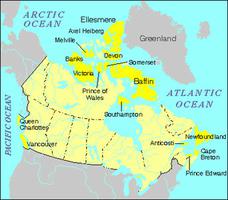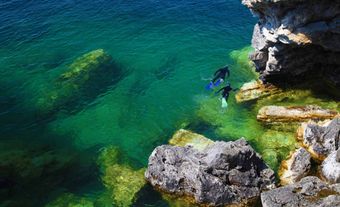The Truelove Lowland area of the island has diverse vegetation and wildlife, an abundance of soil water in the summer owing to blocked drainage, and greater precipitation and higher summer temperatures (4° to 8°C), with more clear days than other parts of the island. The ground is snow free for only 45-50 days each summer. The poorly drained lowlands are characterized by a sedge-moss tundra in which MUSKOXEN graze year-round. Most of the living organisms in this system (98.9%) are plants, with the remainder being herbivores and carnivores, soil bacteria, fungi and INVERTEBRATES that decompose the organic matter.
The peaty soils are cold and wet all summer and have low levels of available nutrients. The island's raised beach ridges of coarse gravels and sands have higher summer air and soil temperatures and drier soils than elsewhere on the island. This system is characterized by a cushion plant (polar semidesert) vegetation on which collared LEMMING feed year-round. Of the living mass in this system, 98.7% are plants, with the remainder being herbivores and carnivores, soil bacteria, fungi and INVERTEBRATES that decompose the organic matter.
On both the beach ridges and wet sedge meadows, the soil invertebrates (worms, protozoa, midge and fly larvae, and collembola) are more productive and consume more organic matter (4.73%) than do the lemming, waterfowl and large muskox. Clearly the tiny insects and other soil organisms are more important in the functioning of this system than are the 15-25 muskoxen that graze in summer and 60-125 that graze in winter in this small oasis in the High Arctic.
Because of the island's short growing season (40-55 days) and low daily summer temperatures (2° to 8°C), plants and animals grow slowly and have a long life cycle. Many invertebrates that take from a few weeks to 1 or 2 years to complete their life cycle in temperate regions require 2-9 years at these latitudes. While the same basic ecosystem components are found in a Saskatchewan grassland or an Ontario hardwood or coniferous forest as those in the High Arctic, the diversity of species, rates of organismic growth and levels of ecosystem production are much reduced, owing to the limited solar-energy input into these cold and nutrient-deficient systems near the top of the world.

 Share on Facebook
Share on Facebook Share on X
Share on X Share by Email
Share by Email Share on Google Classroom
Share on Google Classroom




